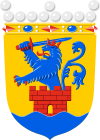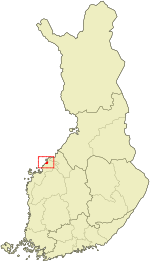Jakobstad
| Jakobstad Jakobstad – Pietarsaari | |||
|---|---|---|---|
| — Town — | |||
| Staden Jakobstad Pietarsaaren kaupunki | |||
| The old Town Hall | |||
| |||
| Location of Jakobstad in Finland | |||
| Coordinates: 63°40′N 022°42′E / 63.667°N 22.7°ECoordinates: 63°40′N 022°42′E / 63.667°N 22.7°E | |||
| Country | Finland | ||
| Region | Ostrobothnia | ||
| Sub-region | Jakobstad sub-region | ||
| Charter | 1652 | ||
| Government | |||
| - City manager | Mikael Jakobsson | ||
| Area(2010-01-01)[1] | |||
| - Total | 396.3 km2 (153 sq mi) | ||
| - Land | 88.33 km2 (34.1 sq mi) | ||
| - Water | 307.97 km2 (118.9 sq mi) | ||
| Population (2010-03-31)[2] | |||
| - Total | 19,643 | ||
| - Rank | 58th largest in Finland | ||
| - Density | 222.38/km2 (576/sq mi) | ||
| Population by native language[3] | |||
| - Swedish | 56.4% (official) | ||
| - Finnish | 40.2% (official) | ||
| - Others | 3.4% | ||
| Population by age[4] | |||
| - 0 to 14 | 17.4% | ||
| - 15 to 64 | 62.7% | ||
| - 65 or older | 19.9% | ||
| Time zone | EET (UTC+2) | ||
| - Summer (DST) | EEST (UTC+3) | ||
| Municipal tax rate[5] | 20.25% | ||
| Website | www.jakobstad.fi | ||
Jakobstad (Finnish: Pietarsaari) is a town and municipality in Ostrobothnia, Finland. The town has a population of 19,643 (31 March 2010)[2] and covers a land area of 88.33 square kilometres (34.10 sq mi).[1] The population density is 222.38 inhabitants per square kilometre (576.0 /sq mi).
Contents[hide] |
[edit] History
The town was founded in 1652 by Ebba Brahe, the widow of the military commander Jacob De la Gardie, and was granted city privileges by Queen Christina of Sweden. The Swedish name literally means Jacob's City or Jacob's Town. The town was founded at the old harbour of the parish Pedersöre and this name lives on in the Finnish name of the municipality, Pietarsaari, literally Peter's Island. Pedersöre remains an independent municipality neighbouring Jakobstad.
The city grew slowly at first, with the authorities scarcely promoting any growth. In 1680 the inhabitants were ordered to relocate to the cities of Kokkola, Oulu and Nykarleby, but the order was rescinded. Wars also contributed to the slow growth, and the city was invaded by Russian troops twice during the Greater Wrath, and large parts of the town were burnt to the ground. A majority of the inhabitants fled the city. While those with means moved across the sea to the Swedish side, others took shelter in the forest or in the archipelago. Many were captured or killed. During the 1720s, some of the previous inhabitants returned, while newcomers also added to the population. The subsequent decades were finally marked by a period of growth, and the current church was built in 1731.
The economic foundation was laid in the mid 18th century, with tar manufacturing and tobacco packaging at its centre. Trade started to develop rapidly in Jakobstad as of 1765, when the cities along the Finnish shore of the Gulf of Bothnia were granted privileges by the Swedish crown to trade directly with foreign countries. This also led to shipbuilding becoming a major activity in Jakobstad. The first ships to sail with goods to foreign countries were the galeas Jacobstads Wapen and the brig Enigheten. Trade and shipbuilding made Jakobstad a wealthy city, and a notable businessman of that time was the merchant and shipbuilder Adolf Lindskog, who also became one of the richest men in Finland.
The early 19th century was a time of upheaval, which saw the 1808–1809 war between SwedenRussia, as well as a devastating fire in 1835 that destroyed approximately half of the city. Despite this, the economic progress continued, and a brewery, a matchstick factory and several banks were founded after 1850. In 1859, the merchant and shipowner Peter Malm started a steam powered sawmill, which was only the second such installation in Finland. The Crimean War was a major setback to shipping industry, as the British navy puts up an effective blockade and the shipping fleet in Jakobstad is reduced from 26 ships to 9. and
Notable businessmen in the 19th century were Otto Malm and Wilhelm Schauman, the latter founding a chicory (coffee substitute) factory in Jakobstad in 1883. This moment in time is usually considered as the start of industrialization in Jakobstad. In 1900, the Strengberg tobacco factory was the largest employer in Jakobstad.
An artillery school was located in Jakobstad during the Finnish civil war. During WWII, the city was bombed once by Soviet bomber planes, causing a few casualties. Up until the 1960s, the town was overwhelmingly Swedish speaking, but as a consequence of industrial expansion in the 1960s and 1970s, the need for additional work force caused a large influx of Finnish speakers. The town remains bilingual with 56% being Swedish and 40% Finnish speakers.[3]
[edit] Notable people from Jakobstad
- Karl and his son Walter Nars, pioneers in Finnish plastics manufacturing with their company Oy Nars Ab (originally from Purmo but establishing their business activities in Jakobstad).
- Fredrik Norrena, former goaltender for the Columbus Blue Jackets
- Jonas Portin, Finnish football national team defender who plays Italian Serie B team Ascoli_Calcio_1898
- Jens Portin, Finnish defender who plays Swedish Allsvenskan team Gefle IF
- Roman Eremenko, Finnish football national team midfielder who plays Ukrainian team FC Dynamo Kyiv
- Alexei Eremenko Jr., Finnish football national team midfielder who plays Ukrainian team FC Metalist Kharkiv
- Fredrik Svanbäck, Finnish midfielder who plays Swedish Superettan team Landskrona BoIS
- Tomas Sandström, former ice-hockey player who played NHL and Swedish National Ice-Hockey team.

- Johan Ludvig Runeberg, the national poet of Finland, was born in Jakobstad.
- Ossian Schauman, the founder of the Swedish-speaking non-governmental organization Folkhälsan, was born and spent his youth in Jakobstad. Folkhälsan [6] provides social welfare and health care services in Finland.
- Philip Ulric Strengberg was a prominent businessman and majority owner of the local tobacco factory in the 19th century.
- Joanna Lindén is an art historian, journalist and photographer.
- Mathias "Vreth" Lillmåns, singer of Finnish metal band Finntroll
[edit] Culture and sights
- Jakobstad is the home of the galeas Jacobstads Wapen, a full scale replica built between 1987 and 1992, based on the original 1755 drawings by Swedish naval architect Fredrik Henrik af Chapman [1]
- The Arctic museum Nanoq is located outside Jakobstad.
- The botanical garden Skolparken, with approximately 1,000 plant species, is renowned both as one of the most northerly botanical gardens in the world and for its classical park architecture. The foundation was laid in 1915 and the park was completed in 1932. The funding was provided by the Schauman family, who wanted to honour the memory of Elise and Viktor Schauman. The park was designed by the prominent Finnish garden architect Bengt Schalin.
- Skata is a protected residential area close to the city centre which dates from 1783. Up until the late 19th century, Skata was home primarily to sailors and their families. As of the 1890s, it transformed into a mainly working class area, providing housing to a large part of the work force employed by the Strengberg tobacco factory.
[edit] Sports
The town's football team FF Jaro plays in Veikkausliiga, the first league in Finland. The woman's league football club FC United has been very successful over the years.
[edit] References
- ^ a b "Area by municipality as of 1 January 2010" (in Finnish and Swedish) (PDF). Land Survey of Finland. http://www.maanmittauslaitos.fi/Pintaalat_kunnittain_1.1.2010.pdf. Retrieved 27 March 2010.
- ^ a b "Population by municipality as of 31 March 2010" (in Finnish and Swedish). Population Information System. Population Register Center of Finland. http://www.vrk.fi/vrk/files.nsf/files/ACFC13B2F489698CC22577030039BD73/$file/20100331.htm. Retrieved 13 April 2010.
- ^ a b "Population according to language and the number of foreigners and land area km2 by area as of 31 December 2008". Statistics Finland's PX-Web databases. Statistics Finland. http://pxweb2.stat.fi/Dialog/varval.asp?ma=060_vaerak_tau_107_fi&ti=V%E4est%F6+kielen+mukaan+sek%E4+ulkomaan+kansalaisten+m%E4%E4r%E4+ja+maa%2Dpinta%2Dala+alueittain++1980+%2D+2008&path=../Database/StatFin/vrm/vaerak/&lang=3&multilang=fi. Retrieved 29 March 2009.
- ^ "Population according to age and gender by area as of 31 December 2008". Statistics Finland's PX-Web databases. Statistics Finland. http://pxweb2.stat.fi/Dialog/varval.asp?ma=050_vaerak_tau_104_fi&ti=V%E4est%F6+i%E4n+%281%2Dv%2E%29+ja+sukupuolen+mukaan+alueittain+1980+%2D+2008&path=../Database/StatFin/vrm/vaerak/&lang=3&multilang=fi. Retrieved 28 April 2009.
- ^ "List of municipal and parish tax rates in 2010". Tax Administration of Finland. 24 November 2009. http://www.vero.fi/download.asp?id=5853;25512. Retrieved 13 January 2010.
- ^ Folkhälsan
[edit] External links
 Media related to Jakobstad at Wikimedia Commons
Media related to Jakobstad at Wikimedia Commons- Town of Jakobstad – Official site
- Österbottens Tidning – Local newspaper
- Jakobs Dagar
| ||||||||||||||







Ei kommentteja:
Lähetä kommentti